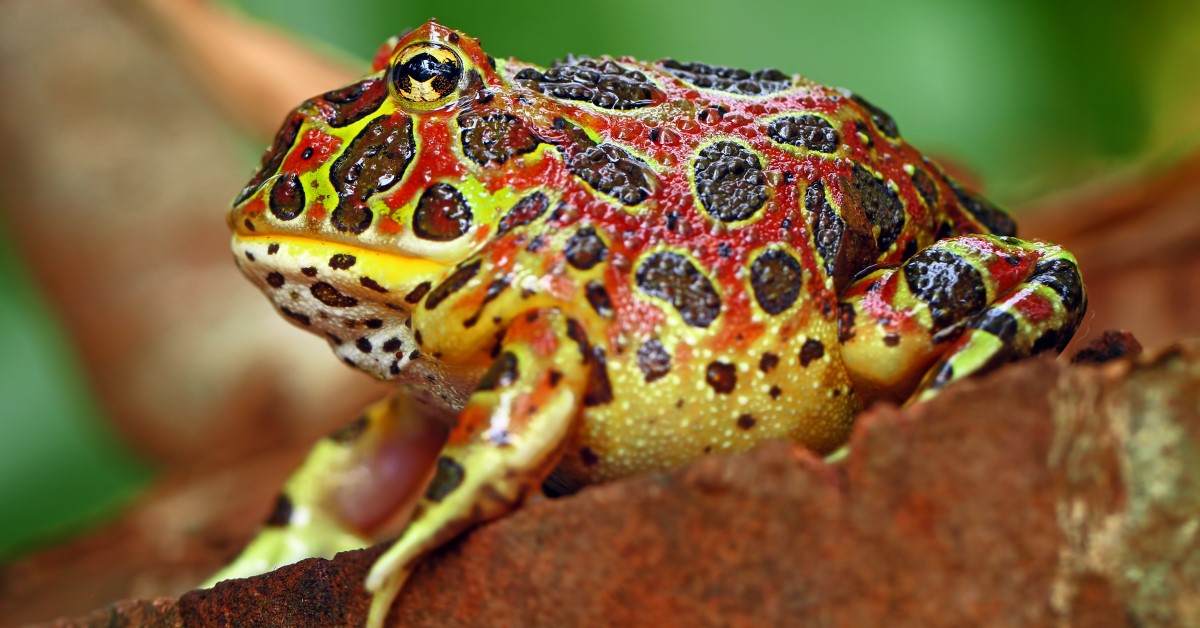Gobble Up These Pacman Frog Care Tips
This hungry frog is relatively easy to care for -- once you know the basics.

Anyone born in the computer era is familiar with the video game phenomenon known as Pac-Man -- but how many of those people are aware of the Pacman frog? This robust amphibian isn't as active as its namesake, making it a fairly easy frog for beginners to look after. Even so, this frog, like so many other species, has its own particular needs and can present certain challenges to their owners. Let's look at the basics of Pacman frog care so you can learn how to keep your pet healthy and happy for years to come.
What Is a Pacman Frog?
Obviously, the Pacman frog was around long before the Pac-Man video game ever existed. You may also hear this native of South America referred to as the Argentine wide-mouthed frog, South American horned frog, or ornate horned frog. The "horns" in question are really just a pair of little pointy growths above the eyes. It was named after the video game character because of its rounded body, large mouth, and compulsion to eat everything it encounters.
A healthy, well-maintained Pacman frog can live for up to 15 years in captivity. These stocky creatures are more active at night -- but even then, they spend most of their time sitting quietly, hiding behind foliage as they wait for prey to approach. Pacman frogs come in a range of interesting color schemes, from brown and green to yellow and pink.
A Typical Pacman Frog Enclosure
Because the Pacman frog doesn't move around all that much and rarely exceeds eight inches in length, it can happily dwell inside a 20-gallon tank or cage even after reaching adulthood. You'll want to line the bottom of your Pacman frog enclosure with bedding materials such as moss and leaf cuttings. Mist this substrate every day to add moisture to the environment. Add a water bowl large enough for your frog to sit in, in case it feels the need to rehydrate itself.
Maintaining the right temperature range for your Pacman frog can get a little trickier. This frog prefers temperatures of 70 to 75 degrees Fahrenheit at night and 75 to 83 degrees Fahrenheit in the daytime. You can provide this warmth by placing incandescent light bulbs beneath the tank. Run fluorescent or ambient room lighting 12 hours each day to simulate a natural day/night cycle.
Don't make the mistake of adding a second Pacman frog to the enclosure as a companion for your new pet. Pacman frogs are so voracious that they have no qualms about eating each other!
The Pacman Frog Diet
Pacman frogs love to eat, and they're not picky about the menu. However, they're also carnivores, getting all their key nutrition from meat. This means that a Pacman frog diet will feature the kind of prey it might consume in the wild.
Small and/or immature Pacman frogs can subsist entirely on a daily helping of insects. Ideally, you should "gut-load" these insects by feeding them a selection of vitamins and minerals before feeding the insects to the frog. This step optimizes the nutritional benefits your frog gets from its meals.
Larger and/or adult Pacman frogs should receive proportionately larger prey. Typical examples include baby rats, baby or medium-sized mice, and even baby frogs. You can get this prey in frozen form at your local pet store. Fortunately, you only have to administer these larger feedings a few times a week. Because this species has sharp teeth, you should feed it indirectly with tongs or similar tools.
Pacman Frog Health Concerns
Like any other animal, Pacman frogs can get sick. Even holding a Pacman frog with your bare hands can transfer harmful bacteria to its skin. (Since it's also a biting animal, you're better off not trying to hold it anyway.) If you must handle your pet, wear rubber gloves pre-moistened with water. Make sure the water does not contain chlorine.
As a concerned owner, you must be able to recognize the common illnesses and symptoms that affect Pacman frogs. These frogs are vulnerable to skin, eye, and respiratory infections as well as infestation by parasites. Watch out for symptoms such as abdominal bloating, drooling, wheezing, obvious redness or irritation, and loss of appetite. These are all signals that you need to take your frog to the vet as soon as possible.
Want a Healthy Frog? Rely on Your Exotic Animal Vet
Before you adopt a Pacman frog, or any kind of frog or toad for that matter, you need to locate a trusted exotic veterinarian in your area. This type of vet has special training in the care of pets outside of the usual dog-and-cat arena, including birds, reptiles, "pocket pets," and amphibians.
Once you have both your veterinarian and your frog, you should set up a wellness exam. Your vet will perform a visual evaluation, take vital signs, and administer lab tests to look for any sign of injury or disease. For instance, fecal samples can reveal whether your Pacman frog has a parasitic infestation that requires treatment. To ensure your pet's ongoing well-being, make this routine wellness exam an annual event.
With the right combination of knowledge, effort, vigilance, and a little luck, you can give your Pacman frog the best possible life. Have fun with your new friend!
Ready to start saving money on pet wellness care?
Then take a look at Mint Wellness, the pet wellness plan that provides fast reimbursement on routine pet care. Save on vaccinations, wellness exams, preventatives, dental, and more!
Learn More